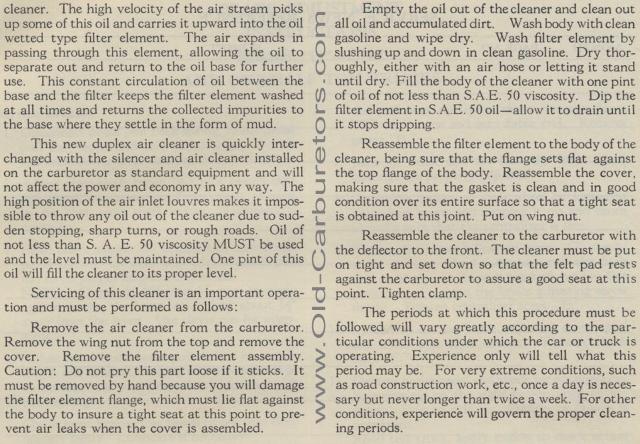cleaner. The high velocity of the air stream picks up some of
this oil and carries it upward into the oil
wetted type filter element. The air expands in passing through this element, allowing
the oil to separate out and return to the oil base for further
use. This constant circulation of oil between the base and the
filter keeps the filter element washed at all times and returns
the collected impurities to the base where they settle in the form
of mud.
This new duplex
air cleaner is quickly inter-changed with the silencer
and air cleaner installed on the carburetor as standard equipment
and will not affect the power and economy in any way.
The high
position of the air inlet louvres makes it impossible to throw
any oil out of the cleaner due to sudden stopping, sharp turns,
or rough roads. Oil of not less than S. A. E. 50 viscosity MUST
be used and the level must be maintained. One pint of this oil
will fill the cleaner to its proper level.
Servicing of this cleaner is an important
operation and must be
performed as follows:
Remove the air cleaner from the carburetor. Remove the wing nut
from the top and remove the cover. Remove the filter element assembly.
Caution: Do not pry this part loose if it sticks. It must be removed
by hand because you will damage the filter element flange, which
must lie flat against the body to insure a tight seat at this point
to pre-vent air leaks when the cover is assembled.
Empty the oil out of the cleaner and clean out all oil and accumulated
dirt. Wash body with clean gasoline and wipe dry. Wash filter element
by slushing up and down in clean gasoline. Dry thoroughly, either
with an air hose or letting it stand until dry. Fill the body of
the cleaner with one pint of oil of not less than S.A.E. 50 viscosity.
Dip the filter element in S.A.E. 50 oil — allow it to drain
until it stops dripping.
Reassemble the filter element to the body of the cleaner, being
sure that the flange sets flat against the top flange of the body.
Reassemble the cover, making sure that the gasket is clean and
in good condition over its entire surface so that a tight seat
is obtained at this joint. Put on wing nut.
Reassemble the cleaner to the carburetor with the deflector to
the front. The cleaner must be put on tight and set down so that
the felt pad rests against the carburetor to assure a good seat
at this point. Tighten clamp.
The periods at which this procedure must be followed will vary
greatly according to the particular conditions under which the
car or truck is operating. Experience only will tell what this
period may be. For very extreme conditions, such as road construction
work, etc., once a day is necessary but never longer than twice
a week. For other conditions, experience will govern the proper
cleaning periods.
 |
